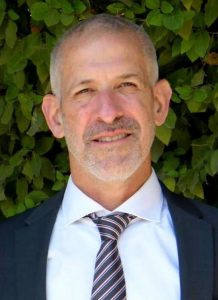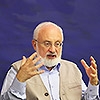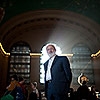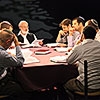Audio Version Of The Blog – 9/14/22
Listen to an Audio Version of the Blog
Download:MP3 Audio

Listen to an Audio Version of the Blog
Download:MP3 Audio
 From My Facebook Page Michael Laitman 9/14/22
From My Facebook Page Michael Laitman 9/14/22
A few days ago, Ronen Bar, head of Israel’s Shin Bet security service, gave a lengthy presentation where he outlined Israel’s security problems. The presentation made waves all over the Israeli media not because there was new information about our enemies that was not known before, but because Bar blamed us for our problems, and not in the military sense, or because of some inherent problem with Israel’s intelligence service. The fault he pointed to was internal division.
Bar did not mince words: “From the intelligence that we have read, from the interrogations of attackers we have conducted, and also from many years of familiarity with our adversaries, wherever they are, we can say today without a shadow of a doubt that the political instability, the growing internal division, the breaking up of the historical common denominators, and the radicalized discourse — all these are a shot of encouragement to the countries of the axis of evil, to terrorist organizations, and to lone threats,” he said. “The prevailing feeling among our adversaries, Bar added, “is that our historic comparative advantage, the same one that stood to our credit for thousands of years and is our national resilience, is dissipating,” he added. “This insight should trouble us more than anything else.”
Clarifying what he meant by “national resilience,” Bar said, “[The] deep rift that is developing within Israeli society” is the “most complex” challenge it is facing. However, Bar also admitted, “In this matter the Shin Bet can only warn; it certainly cannot deal with it,” he said. “It is in the hands of each and every one of us.”
Bar is correct. Our weakness stems from our division. His statement said nothing new. Our very peoplehood is based on unity, we introduced to the world the concepts of mutual responsibility, solidarity; and unity, and we built a society whose kings taught not to change others, but to connect with them just as they are. In those days, “Love your neighbor as yourself” was not an election slogan; it was the prerequisite that enabled the proclamation of our people as a nation.
At the foot of Mt. Sinai, we heard the threat for the first time: Unite “as one man with one heart,” or the mountain will turn on you and bury you like a vault. Since then, every time we disunited, a different kind of “vault” had buried us. It started with Nebuchadnezzar II, who destroyed the First Temple and sent us to exile in Babylon, continued with General Titus, who destroyed the Second Temple and sent us to an exile that has only recently (partially) ended. In later times, King Ferdinand expelled us from Spain, and in the previous century, Hitler wiped out European Jewry almost in its entirety.
In all those calamities, Jewish division intensified prior to the onset of the evildoer’s onslaught. Moreover, in many such cases, Jews, or Jews who converted into another religion (or their parents) were among the fiercest and cruelest enemies of the Jews. The commander who led the attack on Jerusalem in the destruction of the Second Temple was Tiberius Alexander, a Jew who was born in Alexandria, and whose father built the doors to the Temple. Before he charged into Jerusalem, he slaughtered 50,000 Jews in his hometown Alexandria.
In Spain, the prime ideologist behind the Spanish Inquisition was Tomás de Torquemada whose parents or grandparents were conversos (Jews who converted into Christianity). Even when the Nazis came to power, there were German Jews who joined the Nazi Party and were avid followers of Hitler. And when Arab rioters slaughtered Jews in Palestine before the establishment of the State of Israel, mutilated their bodies, and violated the women before they butchered them, some Jews hailed those Arabs as heroes.
Berl Katznelson, among the prominent Zionist leaders of the Labor movement in Palestine before the establishment of the State of Israel, said about such self-hating Jews in May 1936: “Is there another nation whose members have come to such emotional and intellectual deformity that everything their nation does … is despicable and detestable, and everything their people’s enemies do, every murder and every rape [and there were countless] fills their heart with admiration?”
The current audacity of our enemies is therefore nothing new. It is merely a continuation of the same pattern we have seen throughout the history of our people.
The only way we can emerge from the cycle of destruction—because this is where it is leading—is to re-embrace unity “as one man with one heart.” This is our legacy; this is our only source of strength; and this is our only way to avoid another turning of the vault over our heads. As Bar said, “This insight should trouble us more than anything else,” and “It is in the hands of each and every one of us.”
For more on this topic, see my book The Jewish Choice: Unity or Anti-Semitism: Historical facts on anti-Semitism as a reflection of Jewish social discord.

Photo Caption:The head of the Shin Bet, Ronen Bar. Wednesday, October 13, 2021. Photo credit: Amos Ben Gershom / GPO.
 In Ein Sof it is a “simple desire” because He is One and His Name One. The light in Ein Sof is called He and the will to receive is called His Name, and they are simple unity without any form of separation (Study of the Ten Sefirot, Part 1, Chapter 1).
In Ein Sof it is a “simple desire” because He is One and His Name One. The light in Ein Sof is called He and the will to receive is called His Name, and they are simple unity without any form of separation (Study of the Ten Sefirot, Part 1, Chapter 1).
Question: What does it mean “He is One and His Name One”?
Answer: The Creator is the force itself and His name is what this force produces.
The essence of the Creator, in principle, cannot be attained by us. His actions are the actions of the Creator within us, and based on them we can decide what His essence is. But all the same, this is not the essence of the Creator Himself, but the essence of His revelation to us, the Good and Does Good. Eventually, this is what we attain.
Question: Can we say that He is the force, light, and His name is the will to receive, creation?
Answer: Yes. As a result of the way we feel and explore His influence on us, to that extent we attain Him.
Question: What is this state of “simple unity”?
Answer: Simple unity is what we can reach as a result of our similarity with the Creator, i.e., the gradual coming closer to Him, up to the adhesion. Although we are absolutely opposite to Him since He created us, as it were, as His imprint, based on this imprint, we become similar to the Creator, and eventually we begin to feel Him.
[302595]
From KabTV’s “The Study of the Ten Sefirot (TES)” 8/14/22
Related Material:
The Creator Is What Is Revealed in the Desire
Approach and Attain
Relationships In Which The Creator Is Revealed
 When it rose upon His simple desire (30) to create the worlds and emanate the emanated beings to bring the perfection of His deeds, His names and appellations to light, which was the reason of the creation of the worlds (Study of the Ten Sefirot, Part 1, Chapter 1).
When it rose upon His simple desire (30) to create the worlds and emanate the emanated beings to bring the perfection of His deeds, His names and appellations to light, which was the reason of the creation of the worlds (Study of the Ten Sefirot, Part 1, Chapter 1).
Question: Does this mean that the Creator created worlds and created beings to show the perfection of His actions?
Answer: Basically, yes. The Creator created the worlds and created beings in order to reveal His perfection and the perfection of His actions to the created beings who would be able to attain His actions and through them to attain Him.
The Creator Himself is concealed, He is unattainable. Only His actions are attainable because He reveals Himself in them. Through His actions we can imagine who He is, although the very essence of the Creator is unattainable to us.
[302552]
From the 3rd part of the Daily Kabbalah Lesson 9/4/22, Writings of Baal HaSulam, Study of the Ten Sefirot
Related Material:
The Reason for the Creation of the Worlds
Tree of Life —The Book About the Creation of the Worlds
Before the Beginning Of Creation
 After the creation of Malchut of the world of Ein Sof, nothing else changed. This is the only form in reality, the Malchut of Ein Sof, in which desire and light are in perfect fusion, harmony, and unity according to the principle: “He and His name are one.”
After the creation of Malchut of the world of Ein Sof, nothing else changed. This is the only form in reality, the Malchut of Ein Sof, in which desire and light are in perfect fusion, harmony, and unity according to the principle: “He and His name are one.”
All other states represent a kind of cover of this perfection. They hide it from us and therefore are called “worlds (Olamot),” which means “concealments (Halamot),” the ten concealing Sefirot that as if absorb the light and conceal it from us who are in this world.
Therefore, if we want to get closer to the world of Ein Sof, we must learn to look correctly at ourselves and at the environment, at the world we are in, over and over again so that this picture takes an increasing similarity to the world of Ein Sof. This means that “He and His name are one.”
As far as possible, we find out who “He” is, what “His name” is, how and with what details of perception, to solder them into one. This is how we move up the degrees of the ladder of spiritual worlds back to Ein Sof.
From here it becomes clear that the stairway and the worlds are not outside, but inside. All these veils of Ein Sof, in which we are now, are layered in ourselves. And they are needed so that we gradually reveal where we are; we reveal ourselves by our own efforts. The more reason I gain, the greater my excitement and inspiration, the more desires I will gain, and I will develop myself to become a resident of the future world, the world of Ein Sof.
This is why we are given the environment of this world. If a person uses all his aspects and elements correctly, then everything is in his power. And if not, then, according to the level of his development, he is under pressure: crises, wars, problems, and disasters of various kinds. Together they clamp him “in a vise” and direct him in the right direction so that he begins to build this world for himself in ever greater similarity with Ein Sof.
[42776]
From the 4th part of the Daily Kabbalah Lesson 5/11/11, Rav Yehuda Ashlag ”Peace in the World”
Related Material:
Creation’s Worst Nightmare
From Love To Hatred And Back To Love
Who Decides: Desire Or The Light?
 The flower buds are the patriarchs, who entered in thought and entered the next world, Bina, and were hidden there.
The flower buds are the patriarchs, who entered in thought and entered the next world, Bina, and were hidden there.
From there, they came out in concealment and were hidden in the true prophets. Joseph was born and they hid in him.
Joseph entered the holy land and erected them there. As it is written: Joseph was born, who is Yesod de Gadlut. (Zohar for All, “The Flower Buds,” Item 5)
Our entire connection with the spiritual world passes through the Partzuf of Nukva of the world of Atzilut. It is to it that broken souls raise MAN, a request for correction.
A person with a point in his heart yearns for the spiritual world, and spirituality is bestowal and unity. Therefore, he strives to unite with others, and he is given such an opportunity in the group.
If a person fulfills the condition of the ascent and creates a Kli, he connects with Malchut de Atzilut. It raises the common request of the friends to Zeir Anpin, and Zeir Anpin gives them the reforming light. Then the souls who want to become one ascend the degrees of unity.
First, to the state of an embryo (Ibur). Here they annul themselves before each other and unite. Everyone bows his head to the environment and becomes an “embryo in the mother’s womb.”
Then they reach the stage of nursing (Yenika), where their connection grows stronger. Now they are already able to work with their will to receive, to rise above it.
Then the souls move to the state of maturity (Gadlut). The level of their connection allows them to connect with Zeir Anpin, and this stage is called Yesod de Gadlut, or Joseph.
From here we can understand the story of Joseph described in the Torah, whom his brothers sold into slavery. These events unfold around the fight for our connection so that we achieve mutual guarantee (Arvut) to the extent sufficient to reveal the Creator between us.
[28446]
From the 1st part of the Daily Kabbalah Lesson 12/2/10, The Book of Zohar, “The Buds”
Related Material:
Invitation to The Bride’s Chamber
A Rose Among The Thorns
Working With The Light
 Question: Can you give a clear example of the difference between slander in spiritual work and slander in dissemination?
Question: Can you give a clear example of the difference between slander in spiritual work and slander in dissemination?
Answer: I should treat my friend like I treat my child whom I love and want everything to be fine with. Of course, I can say that he is lazy at school or sometimes fights with his friends. But all the same, love is felt in my words and kindness shines through them.
Speaking of a friend, I do not pursue evil. I do not say this so that others will also feel the same attitude toward him. Let’s say I do not like how someone made a video about me.
I can say that there is not enough light, bad sound, that he did not try to post the clip on the Internet in such a way that everyone would see how smart and beautiful I am, but instead he did it differently. But this speaks of professionalism, of an unsuccessful resolution of the issue, and I can discuss this.
We openly consider such issues at our meetings and conferences and learn from this. Nevertheless, they do not interfere with the fact that I consider him my friend and treat him with a desire to get closer, to unite.
First of all, we need to look at each other through the prism of love and unity; otherwise, why are we together? To reveal the upper force in the connection between us. And the one who speaks evil makes a break in the network between us, and nothing that we expect will happen. Therefore, I am very strongly against this and I ask everyone to take it into account.
There is no greater evil than harmful speech (Lashon Hara) when you spread such an attitude toward others and set others in such a way, even if they do not want to listen to gossip, even listening to them is very bad. We need to fight against this seriously.
[302371]
From KabTV’s “I Got a Call. Beware of Gossip!” 3/19/13
Related Material:
Why Is Criticism Encouraged in Kabbalah?
Is It Better to Be Kind or Evil?
Signs Of The Beginning Of The Correction
 Question: What should be done if a person hears slander against someone?
Question: What should be done if a person hears slander against someone?
Answer: Say that you do not want to hear it, cut it off, and in this way you will teach a friend to do the same. This is a great correction for the group.
Question: If women are discussing someone, is it natural for them to group into cliques?
Answer: They can do whatever they want, but then they must understand that they are not walking along the spiritual path with us. The Kabbalistic group must be equal, absolutely homogeneous.
If someone slanders, then in theory he multiplies evil, this diverges like a virus. You can fight this only by having a good relationship with everyone and covering everything with love. If a person is in a group, then he was brought here and we must accept him as a closest one.
Question: How can I teach myself not to give criticism outwardly, not to utter it?
Answer: Through habit, example of others, constant self-criticism, and introspection.
Question: You said that before a certain period, a person is still learning. At the initial stage is it acceptable to gossip?
Answer: No. As soon as a person arrives in the group, we must immediately inform him about this and teach him like a child, and constantly point out to him the inadmissibility of slander.
There must be an awareness of the importance that without this we will not reach the goal. I hope that everyone will understand this, and in the end they will reach the goal. I will not be hurt so much that they themselves break the ties in which they can reveal their highest state.
[302407]
From KabTV’s “I Got a Call. Beware of Gossip!” 3/19/13
Related Material:
Why Is Criticism Encouraged in Kabbalah?
Is It Better to Be Kind or Evil?
Signs Of The Beginning Of The Correction
Preparation to the Lesson
| [media 1] | [media 2] |
Lesson on the Topic, “Purifying the Heart”
| [media 3] | [media 4] |
Lesson on the Topic, “Connecting the World in the Last Generation”
| [media 5] | [media 6] |
Selected Highlights
| [media 7] | [media 8] |